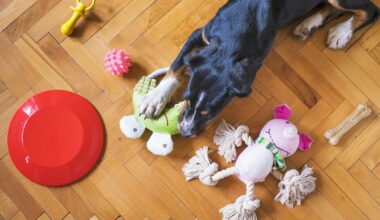Safe Toy Choices to Prevent Choking and Injury at Home
When it comes to choosing toys for your dog, safety should always be a priority. Many toys are designed with specific breeds or sizes in mind, but not all are suitable for every dog. Selecting a toy that is too small can pose a choking hazard. Always consider your dog’s size and chewing strength before making a purchase. Opt for toys that are made from durable materials to prevent breakage and ingestion of pieces. Look for toys that are specifically labeled as non-toxic and safe for pets. Avoid toys with small parts that can be chewed off easily and potentially swallowed. Additionally, it is essential to inspect toys regularly for wear and tear; discard any that show signs of damage. In addition to physical safety, considering your dog’s behavior is important. Some dogs are aggressive chewers, while others are more gentle. Understanding your dog’s chewing habits allows you to select toys appropriate for their individual needs. Always supervise playtime, especially for young or unfamiliar dogs, to ensure they stay safe while enjoying their toys. A keen eye can prevent accidents before they occur.
Another key aspect is understanding the material used in toy production. Toys made of rubber, canvas, or natural fibers tend to be safer options. These materials are often more durable and less likely to splinter compared to others. Rubber toys can withstand heavy chewing, making them ideal for aggressive chewers. If a toy begins to break or tear, it is essential to dispose of it immediately. Also, consider selecting toys that encourage interaction. Toys that engage your dog mentally stimulate their minds and reduce boredom, which can lead to destructive chewing. Stimulation is crucial for a dog’s overall happiness and can help prevent behavioral issues at home. Look for puzzle toys or those that dispense treats; these types of toys can keep your dog occupied for extended periods. When purchasing, always read the product reviews and check for any safety warnings associated with specific products. If you’re uncertain about a brand’s quality or reputation, consult your veterinarian for recommendations. Keeping your dog safe from choking hazards depends on making informed decisions regarding the toys you bring into your home. Research thoroughly to ensure your choices are as safe as possible.
Durability and Supervision
Durability is a crucial aspect in keeping your dog safe; however, supervision during playtime is equally vital. Even the most robust toys can become dangerous if not watched closely. Always monitor your dog while they play, especially with new toys. This is advisable until you’re confident in the toy’s safety and your dog’s ability to handle it. Strong chewers may need more supervision due to their propensity to cause destruction quickly. If you notice your dog chewing in an unsafe manner or becoming overly excited, it’s a good idea to intervene. Teach your dog the difference between safe and unsafe chewing habits as early as possible. Also, avoid using toys that can easily become trapped in your dog’s throat or esophagus. Toys shaped unorthodoxly may look fun but can lead to severe risks. Always provide sufficient alternatives. A variety of differently sized and shaped toys can keep your dog engaged and reduce the urge to chew on inappropriate objects. Rotate toys regularly to maintain interest. This prevents boredom and encourages safer behaviors within your home, ultimately keeping accidents at bay.
Make sure to consider how your dog’s age and activity level play into toy selection. Puppies, for example, have different needs than older dogs. Age-appropriate toys can help with teething and learning. Chew toys that are softer or designed for dental health are ideal for younger dogs. On the other hand, senior dogs require softer, easier-to-chew toys; these help support any dental issues. Regardless of your dog’s life stage, avoid toys that can easily shatter or break into small pieces. Additionally, consider incorporating interactive toys that promote physical activity. Engaging your dog in active play not only fosters a bond between you but also contributes positively to their physical health. Regular exercise can prevent weight gain and offer mental stimulation, both essential for a happy pet. Investing in toys that allow you to play alongside your dog, such as fetch or tug-of-war varieties, can create lasting memories. Breaking the routine with various activities can also keep both your and your dog’s spirits high. Staying active with your dog provides both safety and enjoyment while expending excess energy safely.
Recognizing Unsafe Toys
Recognizing unsafe toys is fundamental to preventing choking hazards and injuries. Some materials can pose significant risks if ingested by dogs. Items like polyester stuffing or beads are often found in stuffed toys, and although they may appear safe, they can create choking hazards. Additionally, squeakers inside toys can also be at risk if your dog successfully removed them. Understand the signs of a compromised toy. If you notice any visible wear, stop play immediately and consider more robust alternatives. More often than not, dogs will attempt to chew apart toys, revealing internal parts that can cause harm. Toys without a label indicating they meet safety standards may also not provide the safest options. Avoid toys from unknown sources or those lacking proper certifications. It’s best to choose products specifically designed for dogs. Researching brands and their safety ratings can prevent potential dangers. Make sure to involve your veterinarian in discussions about toy selection, as they can provide valuable insights into safe options for your dog’s specific breed and chewing style. Knowledge is your best tool in ensuring your dog’s safety within your home.
DIY toys can be a fun alternative; however, they pose their own set of challenges. When creating toys at home, it’s vital to choose safe materials. Avoid any items that could break easily or have components that might be ingested. Materials like old socks, used tennis balls, or sturdy fabric can be suitable as long as they don’t pose risks. Make sure to inspect any homemade toys regularly. Signs of wear may include loose parts or fraying edges, all of which can pose choking hazards. Generally, simpler toys tend to hold up better and keep your dog entertained. Think about engaging your dog’s instincts through fun games and activities that require interaction rather than relying on more complex creations. Your dog may enjoy old boxes or empty water bottles under supervision, encouraging creativity. Even so, it is vital to keep safety in mind during any play, whether with store-bought or homemade toys. Continue to observe how your dog interacts with toys, and maintain an open dialogue with your veterinarian about safe practices to avoid accidents and ensure a healthy, happy pet.
Conclusion on Safe Toy Choices
Ultimately, ensuring your dog’s safety at home revolves around making informed and conscious choices about their toys. Prioritize your dog’s size, chewing behavior, and preferences when selecting. Always remain vigilant during playtime with new toys until you learn how your dog interacts with them. Familiarity is crucial to understanding risks associated with certain types. Regular supervision, along with providing a variety of durable options, can keep your dog engaged and safe. It’s your responsibility to eliminate any hazards and promote safe play activities within your home. Do not hesitate to replace worn-out toys, and be proactive in monitoring your dog’s behavior. Explore interactive toys, as they offer both physical and mental engagement. Keep lines of communication open with your veterinarian for toy recommendations that fit your dog’s profile and health. Remember, ensuring your dog’s safety can support a long, happy life shared between you both. Following these guidelines will not only safeguard your dog but also contribute to their overall happiness and well-being at home. The right toys and practices will create an enriching environment for your canine companion to thrive.
This concludes our article on safe toy choices. Remember that your dog’s safety is in your hands. Be a responsible pet owner by making informed decisions, keeping risks at bay, and ensuring a joyful environment for your furry friend.


